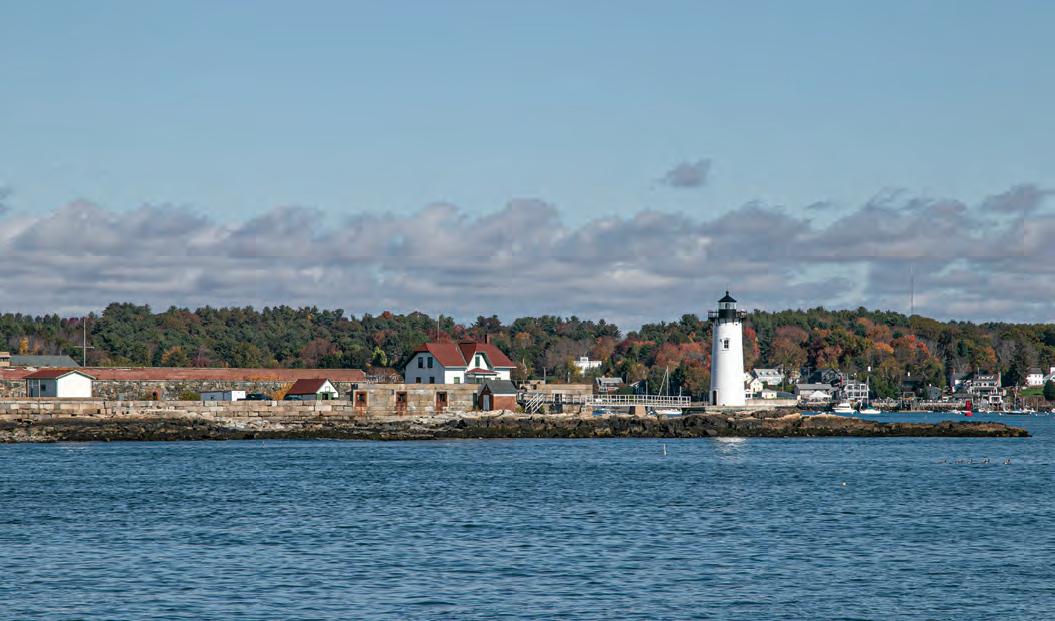
6 minute read
Our Town
New Castle, Portsmouth Lighthouse and Old Fort Constitution at the mouth of the Piscataqua River
A Visit to Historic New Castle
Exploring the town of today with an eye to the past
BY BARBARA RADCLIFFE ROGERS / PHOTOGRAPHY BY STILLMAN ROGERS
Still retaining the air of the prosperous little seafaring village that it was in the late 1600s, New Castle packs four centuries of history into less than a square mile. It’s New Hampshire’s smallest town, its easternmost and the only one completely on islands.
It’s also one of the most pleasant to explore, wandering along its narrow lanes and past houses dating from the 1600s and 1700s. Front doors often open directly onto the streets, as there is often no space for a dooryard.
Several historical “firsts” center around the fortifications at New Castle’s outermost point. Castle was the name for a fort, in this case referring to the “foure grete guns” installed on new earthworks in 1642 to defend Portsmouth Harbor. Even before a blockhouse was built there in 1666, four boats with a force of 40 men gave chase to the notorious pirate Dixie Bull, scaring him off for good in the colony’s first naval engagement.
The fort became increasingly important in the French and Indian War and as Portsmouth Harbor became a major shipbuilding port. In 1692, the British Crown sent cannons and munitions, and the position was renamed Fort William and Mary in the monarchs’ honor. By protecting the harbor, the fort also secured the vessels being built in boatyards along the tidal waters of Portsmouth, Dover and Exeter.
Fort William and Mary continued to grow, as did unrest in the colonies, which were heavily taxed to pay for the British efforts in securing the Crown’s hold on Canada during the French and Indian War. By late 1774, the murmurings had risen to a point where the king prohibited the importation of gunpowder and military supplies to America — on December 13, Paul Revere rode to Portsmouth with the word that more British troops were on their way to reinforce the fort.
Portsmouth patriots reacted quickly to liberate whatever munitions were held there, and 400 of them stormed the fort the following day. Despite musket fire, the local Sons of Liberty captured the fort and emptied it of 100 barrels of gunpowder and all the cannon and small arms they could carry away in gundalows. (It was hidden and later used in the Battle of Bunker Hill.) Although there had been other attacks on particularly troublesome local authorities, this was the first armed attack on a British garrison, the first military engagement of the Revolution.
The name was changed to Fort Constitution, the height of its walls doubled and the brick barracks added, serving through the Civil War. A larger fortification

Atkinson Street to New Castle harbor
of granite blocks was begun around the brick one, but it was never finished. The last military contingent left Fort Constitution in 1958, and in 1961 it was returned to the state as an historic site.
Also on Fort Point, Portsmouth Harbor Lighthouse was built in 1771 after Royal Governor John Wentworth told the Provincial Assembly, which was reluctant to spend the money, that “every future expiring cry of drowning mariner upon our coast will bitterly accuse the unfeeling Recusant that wastes life to save a paltry unblessed shilling.” The 50-foot shingled wooden lighthouse, lighted by three copper oil lamps, was the first lighthouse in the American colonies north of Boston. In the summer, you can climb to its top on Sunday afternoons.
Fort Constitution was one of three in New Castle and one of the seven built to protect Portsmouth Harbor and the naval shipyard. At the end of Wild Rose Lane is the abandoned Fort Stark, the site of earthworks during the Revolution and the War of 1812 and later a stone fort, before the present batteries were built in the early 20th century. Used in both World Wars, the magazines stand empty today, with grass growing from the cracked cement — gun emplacements have begun to slide down the crumbling cliff.
The third, Camp Langdon, began in 1909, used as an anti-aircraft battery in World War I and as the main garrison area for the four local forts in World War II. In 1963, it became a town park, known as Great Island Common. The jetty built by the military is now part of the park, which has a picnic area and sand beach.
We learned more about the island’s history at the New Castle Historical Society, a former church that has also served as the town’s library. Displayed there are pottery, bottles and other artifacts recovered from the wrecks of a schooner and the HMS Astraea, which sank in the Piscataqua
An evolution in legal excellence.
As your business evolves, you need a law firm that shares your vision for the future. That’s us, Sheehan Phinney.
Cook Little has now joined the legal team, Sheehan
to offer you an expanded powerhouse of legal talent in key areas of growth:
Sheehan Phinney is proud to welcome the Cook Little team to our roster of exceptional talent.
> Corporate Law > Technology > Transactional > Start-Up > Employment > Automotive > Data Privacy > Manufacturing
Boston • Concord • Manchester • Portsmouth • Upper Valley

Contact us today Sheehan.com

Overlooking the Atlantic Ocean, the historic Wentworth by the Sea is three miles from both the Strawbery Banke Museum and from the Odiorne Point State Park.
River. A painted theater curtain covering the entire back wall depicts the gates of Fort Constitution.
From a portion of a millstone in the museum’s yard, we discovered that some of the waters we had kayaked around New Castle were once part of two tidal millponds. The 8-to-12-foot tides made the ponds ideal for tide mills, which operated by swinging gates that were forced open by the incoming tide and pushed shut by the outflow. The captured water, released slowly through a sluice and over a waterwheel, operated the mill. The millstone fragment was delivered to the Historical Society’s yard by an exceptionally high tide.
A kayak is a good way to explore these mill ponds, the smaller islands in the Piscataqua that make up New Castle, and the tidal estuary of Sagamore Creek. One of the mill ponds lies directly across Route 1B from the Wentworth by the Sea. That hotel opens another chapter in New Castle’s, and America’s, history.
Portsmouth brewing magnate Frank Jones bought a small hotel in New Castle in the late 1800s, and enlarged it to become the Wentworth-by-the-Sea, one of the premier New England seaside resorts of the Grand Hotel era. In 1906, not long after the owner died, Judge Calvin Page, who managed Jones’ estate, was approached by President Theodore Roosevelt’s staff. They were looking for a place to house the delegates to peace negotiations to end the Russo– Japanese War.
Judge Page offered the hotel free of charge to all the delegates. The meetings would be held at the Portsmouth Naval Shipyard, and delegates could be transported by launch directly between the two. It was a win-win- win: The peace treaty was signed, news coverage made the hotel world famous, and the president got the Nobel Peace Prize. NH

Get There
New Castle NH Historical Society
(603) 436-4440 / newcastlenhhistoricalsociety.org
Wentworth by the Sea
(603) 422-7322 / marriott.com
Portsmouth Harbor Lighthouse
(603) 534-0537 / portsmouthharborlighthouse.org












